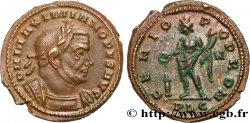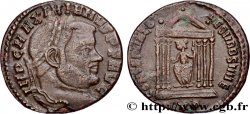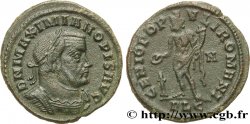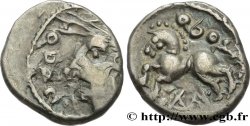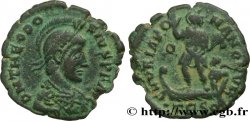v27_0370 - MAXIMIANO HÉRCULES Follis ou nummus
MONNAIES 27 (2006)
Precio de inicio : 120.00 €
Valoración : 180.00 €
lote sin vender
Precio de inicio : 120.00 €
Valoración : 180.00 €
lote sin vender
Tipo : Follis ou nummus
Fecha: été 307
Nombre del taller / ciudad: Lyon
Metal: cobre
Diámetro: 30 mm
Eje de acuñación: 12 h.
Peso: 8,27 g.
Emission: 14e
Comentarios sobre el estado de conservación:
Exemplaire sur un flan extrêmement large, irrégulier et complet des deux côtés avec les grènetis visibles. Portrait magnifique. Frappe un peu molle au revers. Patine gris anthracite avec des reflets métalliques
N° en los catálogos de referencia :
Anverso
Titulatura del anverso: D N MAXIMIANO P F S AVG.
Descripción del anverso: Buste lauré et cuirassé de Maximien Hercule à droite, avec pan de paludamentum, vu de trois quarts en avant (B*01).
Traducción del anverso: “Domino Nostri Maximiano Pio Felici Seniori Augusti”, (À notre seigneur Maximien pieux heureux auguste le plus âgé).
Reverso
Titulatura del reverso: GENIO - POP ROM/ (AUTEL)|N// PLG.
Descripción del reverso: Genius (Génie) debout à gauche, coiffé du modius, le Génie porte l’himation, tenant une patère de la main droite et une corne d'abondance de la main gauche.
Traducción del reverso: “Genio Populi Romani”, (Au Génie du Peuple romain).
Comentario
Avec des traces d’argenture superficielle (3%). Rubans convergents : rubans descendant verticalement le long de la nuque (type 3). Cuirasse cloutée. Épaulière cloutée. Les ptéryges sont larges. Un changement radical intervient dans la représentation du Génie au revers. Il est maintenant normalement revêtu de l’himation au lieu du manteau tombant sur l’épaule (paludamentum). Une autre innovation est l’apparition d’un N dans le champ à droite. Nous nous sommes interrogés sur la présence et la signification de ce N. Il pourrait tout simplement signifier “Nova” (nouvelle) pour rappeler techniquement la réduction du follis du 1/32 L. au 1/40 L. Nous n’avons relevé aucune liaison de coin pertinente. Notre exemplaire est très proche de l’exemplaire du Kunsthistorisches Museum de Vienne n° 35.517, Bastien n° 391c, pl. XLI.
With traces of superficial silvering (3%). Converging ribbons: ribbons descending vertically along the nape of the neck (type 3). Studded cuirass. Studded shoulder guard. The pteryges are wide. A radical change occurs in the representation of the Genius on the reverse. He is now normally dressed in the himation instead of the mantle falling over the shoulder (paludamentum). Another innovation is the appearance of an N in the right field. We wondered about the presence and meaning of this N. It could simply mean “Nova” (new) to technically recall the reduction of the follis from 1/32 L. to 1/40 L. We did not note any relevant die connections. Our example is very close to the example of the Kunsthistorisches Museum in Vienna no. 35.517, Bastien no. 391c, pl. XLI
With traces of superficial silvering (3%). Converging ribbons: ribbons descending vertically along the nape of the neck (type 3). Studded cuirass. Studded shoulder guard. The pteryges are wide. A radical change occurs in the representation of the Genius on the reverse. He is now normally dressed in the himation instead of the mantle falling over the shoulder (paludamentum). Another innovation is the appearance of an N in the right field. We wondered about the presence and meaning of this N. It could simply mean “Nova” (new) to technically recall the reduction of the follis from 1/32 L. to 1/40 L. We did not note any relevant die connections. Our example is very close to the example of the Kunsthistorisches Museum in Vienna no. 35.517, Bastien no. 391c, pl. XLI








 Informar de un error
Informar de un error Imprimir la página
Imprimir la página Comparte mi selección
Comparte mi selección Haz una pregunta
Haz una pregunta Consignar / vender
Consignar / vender
 Descriptivo
Descriptivo